Is it a bird? Is it a plane?

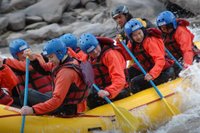
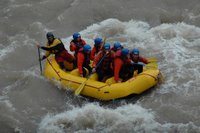
.
no, it´s Superwoman!! :)
Yesterday I flew across a lake at a great speed while flapping my arms.. it was very silly but an experience I just couldn´t pass up. The lake is part of a long river called Rio Mendoza, near the city of Mendoza in Argentina. I flew from the side of one mountain to another, enjoying the beautiful scenery and lake down below... and the tranquility ( i could only hear the wind).. while my body and arms were attached with a harness to a thing cable, and a guide holding onto my legs ;) A distant photographer captured the action on his camera with a big zoom.. ready for publication on the Daily Planet.
Ok, so maybe I´ll have to photoshop out the cables and the guide.. but you should have seen me! A true flying chicken I was. I was so nervous at every single part of the canopy course.. and I wondered why I ever signed up, again, to any of the adventure stuff. I guess the idea of canopy sounded great until I saw the thin cable extending as far as my eye could see. my fear of heights didn´t help. We started with easier and shorter ones, learning the signals and learning how to stop and how to continue if you stop in the middle of the rope. There were two guides, with one sort of explaining things to me in English.. (his English is only slightly better than my Spanish). Nervously we went from one rope to another, and sometimes stopping unexpectedly because we were going too slow and had pull ourselves along for the rest of the way. It was quite a Tazan experience, until the two last ropes where we were given the opportunity to be Superman. I reluctantly agreed to try my arms at flying for the last rope, and it was an incredible..ly.. silly experience and great fun!!!
On the afternoon I went white water rafting down the Rio Mendoza with a different group of people.. but the same guide and photographer. The scenery was again beautiful, and the water was freezing. This time I was not the only English speaker, but the guide only explained things in Spanish, with a few helpful translations from the fellow rafters. There were 7 of us, plus one guide, squashed into one boat. Amazingly we all understood the instructions and survived the river, enjoying the bumps and splashes along the way, and posing for the camera at various moments. It was reminincent of rafting in NZ, but only much much colder! Thank goodness for the warm shower and tea afterwards :)
So here´s my story of the week. And as you can see I´m in Argentina now, a country I heard so much about from friends and other travellers.. a place of amazing steak.. beautiful people.. european influences and delicious icecream and chocolates. And tango. And wine (Mendoza is famous for its wineries). All the travellers rave so much about Argentina that I was almost afraid of being dissappointed. Though I´ve yet to experience the to-die-for steaks, I´ve enjoyed some wonderful dinner buffets (huge variety of salads and deserts plus a main course of your choice) for less than $7.. The shopping is also fantastic here, so I can´t complain.
well, except for the fact that most hostels here don´t have single rooms so I´m staying in hotels and not meeting as many travellers.. but having emails from friends would help to cure the homesickness.. i think.. :) hint.. hint..
Round the world in 150 days (mas o menos..)
Monday, August 28, 2006
Saturday, August 12, 2006
Thank you, strangers...
I nearly missed my bus from La Serena to Valparaiso two nights ago, if it wasn´t for the help of one kind hearted stranger. And in my short two days stay in La Serena I have come across so many helpful people, it was amazing.
Two experiences stand out in particular. One was when I came back from a tour and got off the tour bus in town, but not knowing exactly where I was. I asked a middle aged lady for directions, and she ended up accompanying me to go to the central plaza, then asked everyone where was the nearest telephone centre, so that I could call my mum (to get some urgent information). She accompanied me for nearly an hour, waited for me to finish calling and walked me back to my hostel... when I suggested I was fine and she didn´t need to do all that, she simply said that we are both women and should help each other. And she even gave me her home phone number and her mobile and said to call her if anything goes wrong.
Then when I got back to the hostel I told the hostel family that I´m catching a night bus to the next town. The lady suggested to take a taxi because it would not be safe at night, even though it was fairly close by. There was a guy watching TV nearby, and he heard and offered to walk me to the bus terminal. It was around 11pm, and I thought the bus was at 11:45. I showed him the ticket and he promptly got up and got both of my heavy bags and said we had to get going, it would be better to be early than late. So we walked to the bus terminal, with him carrying my bags the whole time! Then when we arrived I thought we had plenty of time and wanted to rest, but he went and found my bus, and gave my stuff to the driver who was loading the luggage, then said goodbye. I thought it was very early and was surprised that the bus was already there, but when I checked the ticket again I realised that the bus actually leaves at 11:15, so it was very lucky that we made it with moments to spare.
On top of these, the family at the hostel really looked after me during those two short days, and a tourist agency guy let me download pictures from my camera to a CD for free. Another hostel person let me leave my bags at her hostel while I went looking for another (because theirs was full), and an internet cafe lady let me pay her later because I didn´t have the right change at the time.. all in all, everyone have been amazingly kind to me and it surprised me to no end..
Wednesday, August 09, 2006
The Unreal world of the Salar de Uyuni...
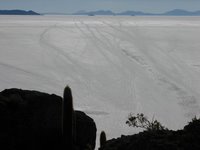
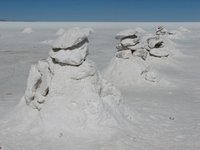


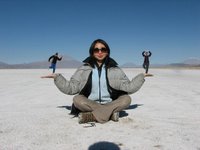 .
.
Gotta start writing about the surreal landscape of the Salar, San Pedro de Atacama desert, and other lagoons we visited during the last week, before it all fade into some distant memeory.
Salar de Uyuni is a huge salt lake at southern border of Bolivia. It is the highlight of any Bolivian trip for most backpackers, and I´m no exception. When you tell Bolivians that you´re going to the Salar, their first reaction is usually "MUY FRIO...!!!" ie. very cold! Everyone I spoke to also agreed, so I bought a very warm jacket, an extra pair of gloves, and some socks in Sucre just for this trip.
From Sucre to Uyuni, I stopped at Potosi. And there I met some very friendly Israelies at my hostel who were also going to Uyuni. In the Uyuni tourist information office I bumped into an Irish guy who I met a couple of times in various places in Bolivia.. and all of us decided to do a tour together, that is we all went with Reli Tour. (The tourist information centre ranks the agencies using tourist feedbacks, and it can change on a day to day basis. Reli was one of the good ones).
Our first stop was the Train Cemetory..where old trains were abandoned. My limited spanish means that I understand less than 50% of what´s said, but that was ok.. as the trip was all about scenery. All six of us, plus our tour guide/driver, and our cook, were squashed into one average sized jeep. I also carried a huge daypack into the jeep (in case the weather turns cold!).. it is squashed up to my legs, and I could not move at all.
Luckily the Israelie guys all brought music, and took care of that for the whole journey. There was one couple, and also one guy and one girl. We all got along fairly well...
About two hours into the trip we reached the beginning of the Salar (salt lakes). Like expected, it was a huge expense of whiteness that resembled snow. In the beginning there were small piles of the salt on the lake, like little dunnes. It´s somewhat strange to be in a place that you have seen so many pictures about beforehand. The typical postcard shot is of the salt lake during the raining season, when the water on the surface of the salt creates a reflection effect.. which makes it look even more surreal. In the dry season, the effect is lost somewhat, but it was still quite amazing.
We quickly got out of the car at the first opportunity, eager to take some silly shots that we have seen from other people. Because the whiteness of the salar extends as far as the eye can see, there was no evidence of perspective or distance, and you could have one person standing at a distance while another stands close to the camera, and from the camera it would seem they are right next to each other, hence you could create strange scenarios with one person half the size of the other, etc..
Then off to see a salt musuem, and salt hotel.. where the interiors were all contructed using salt.
We stopped at the Fish Island for lunch. It is called a fish island because the shape of the island looks like a fish. And it didn´t feel like an island cause we drove there in a car. The island was amazing, with giant cactuses growing all over it.
The lunch was delicious, totally unlike what we´d expected (after hearing so many negative reports from other people and from guidebooks). And the afternoon was spent driving through more of the salar. It was huge. We took some more silly photos, and were the last to arrive at our hotel for the night.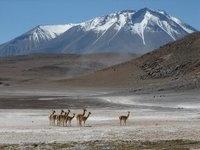



The next day we drove through more of the salt lakes, and visited one lagoon after another.. Each one was more spectacular than the previous. It was also my first time to see flamingos, and of course I couldn´t stop taking pictures of these beautiful birds. We watched sunset at the last lagoon, where there were literally hundreds of flamingos in the distance.. and the lake was in various shades of red and purple due to the algaes..
That night was freezing, but I had been warned by many beforehand, so I wore 4 layers of socks, many layers of thermals and clothing, plus a hat and a pair of gloves to bed. That was in addition to many layers of blankets and a thick sleeping bag. I feel like I was going skiing in my sleeping bag. Half way through the night I woke up feeling too hot, so removed one layer of socks!
The third morning was our last day on the trip and we had an early start (5am) to catch the sunrise. There were about 10 tour groups staying in the same hostel, but we were the last group to leave. As we drove on and on, we could see the sky changing colour outside the car window... it was too late for a proper sunrise, but we got out of the car upon arriving at the geysers, and saw the huge swells of steam filling up the whole landscape. Further on, we stopped at a hotspring for breakfast, and a few of us (including me!) got into the thermal pool despite the subzero temperature outside :) The water was lovely and warm, but it was freezing outside. When my friend laid his swimmers to dry in the sun afterwards, he noticed the water on his pants had turned to ice and the pants were stiff like ice...
We made a trip to the final lagoon (Lagoon Verde?) and the tour concluded at the border of Chile and Bolivia. From there we waited for a connecting bus taking us to the San Pedro de Atacama desert. The first bus was full, and the next one didn´t arrive until a couple of hours later.. San Pedro was also fantastic.. but that´s another story...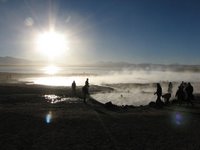



.
Tuesday, August 01, 2006
On top of the world in Potosi



.
Arrived in Potosi a day and half ago, and as I had feared I had a case of high altitude blues involving headache, dizziness and upset stomach. Luckily it´s gone today.
Potosi is famous for its silver mines and for being one of the highest city in the world. At 4070 meters above sea level, it's even higher than La Paz. Coming from Sucre(2750 m), I started to get a mild headache on the taxi on the way here. The city has a somewhat tragic history dating back from Colonial times, when silver was discovered at the foot of the nearby mountain (Cerro Rico) around 1545. For the next 300 years or so, the Spanish government used Indian slaves and imported African slaves to work in the mines to extract the precious silver, and they worked under terrible conditions (shifts of 12 hours at the time and the workers stay underground for four month at a time). It was estimated that almost 8 million African and Indian slaves died from these conditions. A significant amount of silver was extracted from Potosi, and the folklore said that the Spanish could have constructed a silver bridge to Spain and still had silver left over to carry across it. Howver, towards the end of the colonial rule, the mines have finally started to run out of silver, and nowadays they are being used to extract zinc and lead.
The mines nowadays are owned by the miner cooperatives themselves, however the conditions are still almost as terrible now as they were back then. Almost everyone who come here does a mine tour, but I decided to give it a miss because it is supposed to be a very clostrophobic environment, with very polluted air and the general conditions are extremely harsh. It would be interesting to see a documentory on it, but I would not like to get sick before my next destination (Uyuni!).
So instead, I went to the St Francisco convent this morning. It is the oldest church in Potosi. It was built in 1547, but by 1707 it was considered too small, so was demolished and rebuilt in the next 19 years. The interior was spacious and mostly constructed in stone, giving it a very different feel to other churches. Unexpectedly an English speaking tour guide came with the entrance price, and I got a private tour all to myself. There were lots of religious paintings inside, though some were covered in plastic to protect from dust. The best bit was going up to the roof for a view of the city. We walked all over the antiquey roof tiles and got a striking view of Potosi, with the mountain (Cerro Rio) behind it.
This afternoon I went to the Royal Mint (Casa Real De La Moneta) and was lucky again to get an English speaking guide, though most people in the group came from Italy. The musuem mainly contained the equipment used for the minting process, and a large sample of coins (mostly silver) that was made from the 1500´s to the 1800's. The size of the equipment was impressive, as well as the amount of labour required to make a single coin. They had a huge room of wheels with gears just to flatten the silver strips from about 1cm to 0.5mm (in four stages), and then they used manual labour to imprint the designs on the coins.. for example, one person would hammer about 5000 coins in a day. I got to have a go of it myself at the end of the tour, by buying a piece of plain silver from the museum shop and used the equipment with a hammer. It was heavy!
So Potosi used to produce a large amount of coins and export them to Spain and other parts of Europe. However they didn´t get paid for it.. I suppose the Spanish did. Nowadays the Bolivian coins are made by Spain, except for the 5 boliviano coin which was made by Canada I think.. and they have to pay for all of them. Our tour guide also mentioned that at one stage Potosi was one of the richest and most populated city in the world (with 170,000 inhabitants).. now it is one of the poorest. However there are still lots of churches and nice looking building in the city, another remainder of its long history. I nearly wanted to go straight back to Sucre on my first day here because of the freezing weather and the headache.. but now I´m glad that I came.

